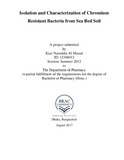Isolation and characterization of chromium resistant bacteria from sea bed soil

View/
Date
2017-08-24Publisher
BRAC UniversityAuthor
Masud, Kazi Nuruddin AlMetadata
Show full item recordAbstract
Chromium (VI) is carcinogenic, highly toxic and mobile in nature. It is considered as an ecological contaminant which is utilized as a part of the majority of the commercial industries and is discharged without treatment. Hexavalent form of chromium can be reduced into trivalent water insolublechromium. The trivalent form is less toxic due to a decrease in bioavailability and they can be used in bioremediation process. Water and soil samples were gathered from the Sitakunda Ship Breaking Yard, seaside locales of Bangladesh, for isolation, characterization and identification of the bacteria which have the potential to convert the cancer-causing chromium (VI) to chromium (III). Nutrient agar medium was used which was supplemented with chromium (VI) as potassium chromate(K2CrO4). By purification on nutrient agar plates, containing different concentrations of chromium, the isolate was obtained. Further the sample was studied. The isolated strain was examined for chromium (VI) reduction capacity in development subordinate way. It was found that the isolate was resistant to Cr (VI) as well as has the reducing activity. The isolated strain was also examined for different antibiotic resistance profile and the result was, the isolate showed mild to moderate resistant to antibiotic. Furthermore, Minimum Inhibitory Concentration was also determined for the isolated strain. Finally the identification of isolate was done by 16s rDNA sequencing method.
